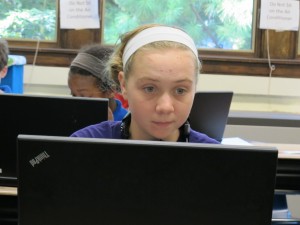Science Program Teaches Middle Schoolers Computing, Fitness Skills

A seventh grader works on a laptop owned by her school in the classroom. (photo credit: Kyle Stokes / StateImpact Indiana)
What do engineering and fitness have to do with each other? Sometimes, a lot. And a middle school program that brings those two topics together, created by researchers at Purdue University, just got a boost.
Alka Harriger, a researcher at Purdue University, received $2.5 million from the National Science Foundation to introduce a simple concept in schools: get young people, especially young women, to see possibilities in computing and engineering jobs.
She also wants them thinking about exercise. So she’s trying a fun approach.
“Building fitness games that are supported with technology,” Harriger says.
That means teaching middle schoolers how to build and wire sensors for games that see how far someone jumps. Or how fast someone runs. It teaches them the science and skills behind technology, but also gives the middle school students a fun reason to get active.
“[It’s] computing and automation done within the context of fitness,” Harringer says.
In select Indiana schools, middle school students could see these concepts seep into elective classes, existing curricula and after school programs.
Using funds from the NSF grant, Harriger and fellow researchers hope to expand and build off an existing afterschool program. Students in that program learn engineering skills, create games and participate in fitness activities.
Harriger says the concepts students learn can actually introduce them to a new style of thought: computational thinking.
“The whole idea with computational thinking is to really get people to focus on how they go about solving problems,” Harriger says.
And, according to leading school technology and computer science organizations, computational thinking gets kids’ brains working in unique ways, including:
- Formulating problems in a way that enables us to use a computer and other tools to help solve them.
- Logically organizing and analyzing data
- Representing data through abstractions such as models and simulations
- Identifying, analyzing, and implementing possible solutions with the goal of achieving the most efficient and effective combination of steps and resources
- Generalizing and transferring this problem solving process to a wide variety of problems
Over the next school year, Harriger and fellow researcher Brad Harriger, will train middle school teachers to teach classes that focus on these skills. It will introduce computer science to students early so they don’t rule it out as a career choice, Harriger says.
“We wanted to get to as young of an age group as we could,” Harriger says. “The reason that it’s not younger than middle school is that we actually have kids working with power, electricty, wiring and so on.”
A total of 165 teachers and around 2,800 students in grades six through eight will be involved. Two schools have already agreed to partner on the effort: Lafayette Sunnyside Intermediate School and Winamac Middle School in Winamac. The researchers are currently searching for middle schools to be involved.
Classes and curricula based on the concepts are expected to reach middle school students during the 2017-18 school year. The afterschool program will continue this year.